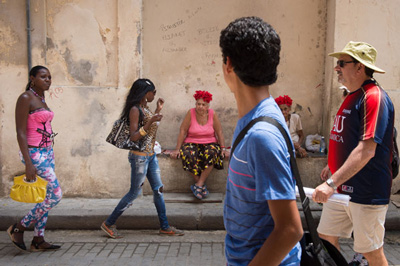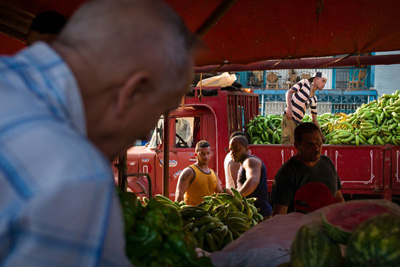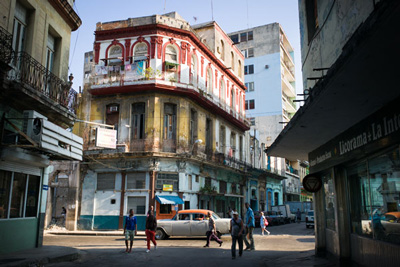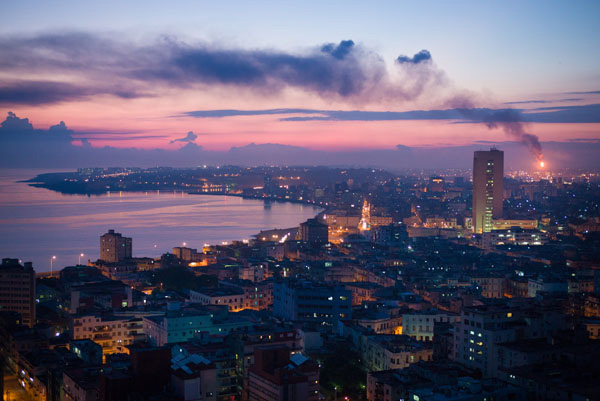Sarasota, Florida Reporter on Her Trip to Cuba
By CARRIE SEIDMAN* (Sarasota Herald-Tribune)
Photos: Elaine Litherland/SHT
HAVANA TIMES — As I boarded the plane at Havana’s José Martí Airport to return to Tampa after a week-long stay in Cuba I felt pulled in two directions.
Part of me couldn’t wait to sit down to go to the bathroom, run on a level sidewalk and breath something other than exhaust-filled air. But the other part wanted never to leave this enchanting island, where music and dance are inextricably woven into the fabric of daily life, the pace is unhurried and the people are as warm as the humid air.
This conflicting pull seemed fitting given that the Cuba I experienced is a land of opposites. It’s a geographically beautiful place that has been marred by pollution and infrastructural neglect. Its people are open and generous but the political climate remains restrictive. There is a high degree of education and appreciation of the arts, but an abysmally low standard of living.
More and more Americans are making the journey to this island 100 miles south of Key West as restrictions have softened. While it’s still difficult for a US citizen to go to Cuba legally as an individual because of Washington’s travel ban, it’s now relatively easy to go as part of an academic, educational, sports or other “exchange” group.
Given my life-long love affair and involvement with dance, I joined a group of ballet students and their teachers going to Havana for a week-long workshop and competition at the Cuban National Ballet school, which offered not only entry but a rare insiders glimpse of the training program that has turned out some of the world’s best ballet dancers.
 When my grandparents traveled internationally in the early days of airplanes, they tried to attend a wedding and a funeral in every country they visited as a way of leaning about the indigenous culture. In Cuba, I’d suggest substituting a baseball game and a ballet performance. The two national passions, they are easily accessible and of uniformly high caliber.
When my grandparents traveled internationally in the early days of airplanes, they tried to attend a wedding and a funeral in every country they visited as a way of leaning about the indigenous culture. In Cuba, I’d suggest substituting a baseball game and a ballet performance. The two national passions, they are easily accessible and of uniformly high caliber.
I didn’t have an opportunity to visit the Estadio Latinoamericano, the 55,000-seat stadium where most national league baseball games are played from November to April, but I did get to see a nonprofessional version. A group of boys gathered in a scrubby, unmarked field neoar the waterfront for a recreational game. There were no uniforms or umpires, the bat was wooden and the “bases” were patches scratched in the dirt, but there was nothing lacking in skill or enthusiasm. A group of friends sat in the shade of the only nearby tree, watching, hooting and snacking from a bag of fresh guayaba fruit. To my mind, ideal conditions.
Ballet and Architecture
As for the ballet, I saw several student performances and was buoyed by what I saw both on the stage and in the house. Unlike the U.S., ballet in Cuba is not an elitist activity. Tickets are a pittance, there’s no need to dress up and if you are moved to applaud something spectacular before the end of a musical movement – and there are lots of opportunities to do so – feel free. After a student performance at the Teatro Nacionale, where the national company is performing during a renovation of its home theater, the aisles looked like a post-game baseball stadium, strewn with snack wrappers and debris.
Many of the city’s other architectural gems – like the nearby domed El Capitolio Nacional, the capitol building – are engulfed in scaffolding as the government has begun making a belated effort to remedy years of neglect. But there is still plenty to see on the tourist trail, from La Floridita, the bar Ernest Hemingway frequented, to the Museo del la Revolución, the former presidential palace, where you can get a heavy dose of history and socialist indoctrination. Next to the Teatro Nacional, I discovered the Plaza de la Revolución, a fascinating museum and monument dedicated to the “father of the Revolution,” poet and writer José Martí, in front of which Castro used to make his most important speeches.
 But I preferred simply wandering the streets and, during the daytime, felt comfortable doing so, even solo. Setting off from our hotel at “23rd and L,” within a block I noticed long lines outside what appeared to be a city park. I assumed it was a central bus pick up and started to walk into the park – until I was stopped by a guard who informed me the assembled masses were patiently awaiting admittance to the “Coppelia,” a famed ice cream parlor inside the park.
But I preferred simply wandering the streets and, during the daytime, felt comfortable doing so, even solo. Setting off from our hotel at “23rd and L,” within a block I noticed long lines outside what appeared to be a city park. I assumed it was a central bus pick up and started to walk into the park – until I was stopped by a guard who informed me the assembled masses were patiently awaiting admittance to the “Coppelia,” a famed ice cream parlor inside the park.
This was one of only two times all week I was curtailed from walking wherever I wanted; the other was when I was asked to leave the Cathedrale de San Cristóbal, a sumptuous Catholic church, because my mid-thigh shorts were deemed “disrespectful.” Otherwise, I went happily from the cleaned up tourist areas of Vieja Habana to the run-down residential neighborhoods where I tripped over broken sidewalks but discovered gems like an outdoor produce market with overflowing bins of plantains, papayas the size of small watermelons and strange herbs sold in tiny bottles to cure various ills.
Though I felt entirely safe, it was hard to walk more than a block without being approached by someone asking “Estados Unidos?” As an American tourist you are a prime target for solicitation, and if you are blond, blue-eyed and beautiful – alas, not me, but my colleague – you will get plenty of cat-calls and smoochy sounds too.
Around Havana, a Photographer’s Dream
As for the salsa scene, you’ll need to venture out at night, late, to one of dozens of nightclubs with live music. It will be packed and the dance floor will be the size of a postage stamp but the innate musicality and movement of the dancers will take your breath away.
If you abandon your American impatience and your expectation that there will be a grocery store around every corner – I never saw anything but small bodegas, selling limited goods – giving in to Havana’s slower pace and embrace of life’s simpler pleasures can be a welcome retreat.
 Though there is cell phone service in Cuba, it is still fairly expensive; phones are not omnipresent and those who have them tend to keep calls short. On the other hand, Cubans seem to have no problem letting a simple question turn into an hour of chat. At the beginning and end of any meeting you will get a kiss on each cheek, which is the way everyone – from wee children to total strangers – says hello or goodbye.
Though there is cell phone service in Cuba, it is still fairly expensive; phones are not omnipresent and those who have them tend to keep calls short. On the other hand, Cubans seem to have no problem letting a simple question turn into an hour of chat. At the beginning and end of any meeting you will get a kiss on each cheek, which is the way everyone – from wee children to total strangers – says hello or goodbye.
Just as you’ve imagined – or seen in pictures – Havana is a photographer’s dream. The buildings painted in pastel colors, the nifty old cars in every color, the artful graffiti of revolutionary slogans on a stuccoed wall or the impressive architecture of the city’s Spanish heritage.
But there is plenty to tear at your heartstrings too – crumbling buildings with jerryrigged wiring, laundry strung from balcony to balcony, primitive plumbing, a skeletal dog lying in a patch of shade. Anything beyond life’s basic necessities is not much in evidence.
In a country where education is emphasized and freely available but upward mobility is extremely limited, it’s only natural that many have been moved to defect. Yet those who remain seem to have retained a fierce love of and commitment to their homeland.
In the wee morning hours of my last night in Havana, after I had been, as a friend calls it, “overserved,” (Oma, esto significa demasiado de tomar) Racael, my waiter at the all-night coffee shop of our hotel asked what time I was leaving in the morning. When I stopped in to say goodbye a mere four hours later, he had ready for me not only a desperately-needed café con leche but a plate of toast, ham and cheese. After I gave him my “promesa” to return one day soon, he refused payment for any of it.
I’m already working on a return trip.
—–
If you go…
My week-long trip to Cuba was a great experience — I’d go back in a heartbeat — but it might have been even better had I realized a few things before I went. Here’s what might come in handy next time.
Know more Spanish
My high school Spanish and two decades of New Mexico Spanglish got me by when it came to cuentas (restaurant tabs), baños (bathrooms) and carros (taxis) and English is spoken in the tourist hotels. But Cubans speak extremely fast and chop off the ends of their words. They were jovially tolerant of my limited vocabulary, but I really wanted to be able to engage more.
Understand the money
Because of the embargo, you can’t get Cuban currency in the U.S. If you change dollars to Canadian bills or euros before you go, you’ll avoid the 10 percent+ the Cuban government takes off the top of any exchange of U.S. dollars. CUCs (convertible pesos) are the tourist currency; they’re basically one-to-one with the dollar (before the penalty); the “other” pesos, CUPs (national pesos) are 25 to the dollar. If you are changing dollars to avoid the penalty before you leave, don’t tell the woman at the foreign currency exchange counter in the U.S. you are going to Cuba (like I did), because she is then legally bound to refuse your transaction.
Leave your paranoia at home
Many Americans have the notion Cuba is a police state and every place you go is bugged. I walked all over Havana and was never questioned and used the hotel wi-fi without any monitoring (I think). Most neighborhoods are safe for walking, at least during the day, though you don’t want to carry or wear excessive valuables. As a tourist, you are a going to be a target for solicitation no matter what; get used to it.
Carry toilet paper with you
Sometimes there is a vieja sitting outside the baños that will hand you a single square of tissue in exchange for your loose change, but don’t count on it. On the whole, public restrooms are lacking in all basic amenities and sometimes also in water and/or toilet seats. Learn to squat.
Pack antiseptic wipes
There are construction projects all around Havana, no pollution control and sanitation is not a high priority. Be prepared to get dirty; if you’re germaphobic, stay home.
Opt for unlicensed cab
Licensed cabs — generally newer model cars — are more expensive and not nearly as much fun as the vintage ones, where you haggle over price before you get in and enjoy the company of others picked up along the same route.
Bring flat shoes and casual clothing
Havana’s sidewalks are uneven, treacherous and sometimes non-existant; women can get by with shorts and tennis shoes event at the ballet, so save your flirty skirt and heels for nightclub salsa. Opt for capris rather than shorts and not too revealing blouses — though if you are young and blond (like my colleague) you are going to be an object of fascination, no matter what you’re wearing.
Bring with you anything (legal) that is essential to your health or happiness
You can’t just walk a block to the corner 7-11 for your red licorice fix at midnight. Havana is not lined with strip malls and the shops that exist often have limited goods and hours. If you must have it, pack it.
Take a full suitcase; leave with an empty one
I wish I’d brought every never-worn impulse buy in my closet. The average Cuban welcomes American goods and would not be offended by your offering them.
Travel with a native
A Cuban companion can act as your interpreter, negotiate prices and deflect solicitors, not to mention get you off the tourist track. I am now accepting offers for my return trip.
—–
(*) [email protected]
Editor’s Note: Sarasota Herald-Tribune staff writer Carrie Seidman and photographer Elaine Litherland recently accompanied Ariel Serrano and Wilmian Hernandez, two former dancers who defected from Cuba in 1993, as they returned to the land of their birth and the ballet school where they both trained. With them were students from the ballet school they founded on Florida’s Gulf coast and their children, including 17-year-old Francisco, a late-bloomer on the brink of a promising career. “Home to Havana,” a three part series that includes Seidman’s story, a documentary video and photos by Litherland and this travel piece, can be found at http://Havana.HeraldTribune.com.







I’ve been there several times . . . read many 1st trip reports . . . I thought you gave a fair report. I hate to read about Cuba being some kind of communist paradise. It has it’s good and bad and that goes for the people you meet there. I agree with you about the pollution . . . all of those old cars (right out of the Godfather) are mostly old junks that make as much smoke as your average bus. My best friend there has cancer so I’ve been to the Havana cancer hospital . . . it is packed . . . that might be from the pollution and the cheap cigarettes and cigars.
Our very different opinions reflect the problems associated with anecdotal experiences. Nonetheless, I hope you would concede that even if police harassment based simply on the Cuban/foreigner association is rare, even one instance is one too many.
Again, even though I look like the estranjero I am, and am often in the company of my Cuban friends, neither I nor they ever get stopped in the non-touristy sections of Habana Vieja, or on San Rafael, other parts of Centro, and of course out in La Lisa, San Agostin, etc. Also, in Santiago, just hang out in Plaza de Marte (rather than Cespedes), or along the the Ave. Jose Saco (pedestrian mall) or Ave. Garzon, and I never have any probs. with police questioning neither friends or myself. Also, of course, in Santa Clara, Sancti Spiritus, Ciego de Avila, Bayamo, etc. I never had such problems (though I would have appreciated some police presence at the Parque de la Ciudad/Lake Turbino in Ciego de Avila, when I was really hassled by an agressive pimp and his two working girls, who just wouldn’t take “no” for an answer!
For an old white guy like you, yes, getting stopped on the street is probably rare under most circumstances. But trust me, if you look Cuban as I do and you walk around with your white tourist friends, whether in Parque Central or in San Miguel de Padron, you should expect to get stopped and asked for “documentos”.
Actually, if you get out of the tourist ghettos, such occurances are rare. For the most part in Habana Vieja, the Vedado, and especially La Rampa, Parque Cespedes, etc. such inturruptons by uniformed police are to safeguard tourists from typical jinatero/a scams. Once out of these zones I was never ever hassled. Also, since 14 years ago, it has been my experience that such harrassment has eased up. Bureaucracy and ineffeciency, on the other hand, are still very much with us. In order to extend my tourist visa another month, I had to visit the immigration office in the Vedado x2, getting there each time at 6:30 a.m. to be near the head of the line when the office opened at 8:00 a.m. (and even before that, having to purchase a $25 stamp at a bank, and unsuccessfully visiting the immigration offices in Baracoa and Santiago, only to be told to wait ’til I returned to Habana near the end of my first month’s stay in order to extend my visa a second month). For the most part, the police do the same thing in Cuba as they do here (investigating crimes, accidents, etc.); also, like both places, a really good policeman has to have the skills of a lay psychologists in calming down family disturbances, mediating disputes between citizens.
Readers of this honest personal experience, should be aware that just as in the US and most other countries, politics separates people into learners and haters. We in the US (less so among our youth) have long been divided into racists and conservatives on one side and liberals and conservatives on the other. US readers know this of course, but don’t always remember to apply the same reality to other countries. Cuba is a country that had an incredible revolution with immense changes and challenges just 50+ years ago – and the battles continue today. So I want to thank CARRIE SEIDMAN for her honest and open minded report.
In addition to her good suggestions, I would add that you definitely should do a bit of study of Cuban history and the politics of pro- and anti-Cuban advocates before your trip. And definitely go and go soon. So much to learn and enjoy.
Nice story. I visited my homeland some 14 years ago and was struck by how plain clothes policemen and women stopped every single conversation I had with locals within 10 minutes. The security appartus was alive and well in Cuba then and from other visitors I understand that not much has changed,
Nice story. I felt exactly the same way after my first visit to Cuba. On my second visit I experienced racism “Cuban-style” and that stung a little. During my third visit, I met my future wife and began to experience the nuances of State Security and came to understand the suffocating nature of Castro-style socialism. The bloom was off the rose at that point.